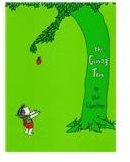English as a Second Language: "The Giving Tree," a Book for Beginners
Shel Silverstein’s “The Giving Tree” can offer a lot of possibilites in an ESL classroom. Its simple language and clear sequence of events
are rich sources for sharpening the comprehension of young ESL learners. At the same time, the illustrations in the book can test youngsters’ inferential skills, coupled with learning art appreciation. The narrative itself, which can be viewed literally and metaphorically, lends itself to be appreciated by different age levels.
Use in Teaching Narratives
The book can be used in teaching elements of a narrative even for young and beginning learners. It has a simple plot with few characters that the students can easily identify.
In teaching the elements of a narrative, a graphic organizer can be used to visually represent these elements. Since the book has a single plot with only two characters, even beginners can easily point out the elements in the book. Obscure elements such as conflict and theme are also easy to recognize.
Silent role-playing or a tableau can be used if the focus of the lesson would be on sequencing events. Without using words, the students can represent what happened in the story. Since the book is highly visual, this can serve as a guide for the students. These activities are beneficial for learners who are still struggling with the language. They are not required to talk but they still have to show their comprehension of the story. These can also be used as a springboard in discussing non-verbal communication for advanced learners.
If the focus would be on showing character development, drawing what happened to the characters before and after the story can be used. The students can select one of the characters or they can also do both. Through a two-panel drawing, they have to show how was the boy or the tree before and after the story. After drawing the characters, they would have to describe the changes that happened in written or oral form.
Use For Making Inferences
Just like most children’s books, the illustrations in “The Giving Tree” play a crucial part in appreciating and understanding the narrative. However, the accompanying pictures of the book are not drawn to show a complete scenario. For example, in the second page, wherein the writer stated “who loved a little boy,” only the boy’s leg is shown at the edge of the page. If the reader is not observant enough, the picture will seem incomplete based on the narration. As for an ESL teacher, the pictures can help in testing the inferential skills of the students.
The book is best read aloud for students. Before reading the words on each page or even before reading the whole story, the teacher can show the illustrations. Then the teacher can ask the students what do they think happened with the tree or with boy. An answer or two are sufficient to continue the story and let them check whether their inferences are correct. For more advanced learners, the teacher can go further by asking them to justify their answers based on the pictures alone. This didactic style of teaching encourages ESL learners to use the language orally and to show comprehension in speech.
Using in Imparting Values
“The Giving Tree” is known for its metaphorical representation of relationships. Depending on the learners’ schema, the text can be viewed as a simple story on generosity or as a matured illustration of abuse. It is up to the teacher to decide what value should be highlighted while reading the story. For young learners, the story can be used as a story about friendship, generosity and sharing. For adolescents, this can be a story of growing up, changes and taking care of the environment. Adult learners can discuss their perspectives on what value does the story have. A variety of activities can be used to bring out the values embedded in the story. The teacher can use role-playing, acrostics or reflection paper. For beginners, a sentence completion such as “From the Giving Tree, I learned that ________________________________________,” can motivate them to think what values they can get from the story.
